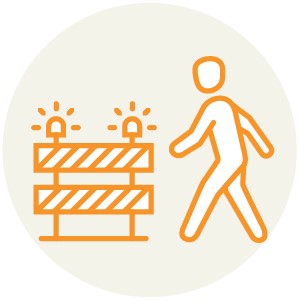Construction and maintenance
On this page
Community engagement – for infrastructure projects
Engagement principles:
- engage early
- build robust relationships
- maintain contact
- consider local circumstances
- reflect and capture learnings.
TMR endorsed guidance
- Active Transport Investment Program Community and Stakeholder Engagement Guide (Department of Transport and Main Roads, 2019)
Planning for pedestrians during construction
Pedestrian paths should be provided on the same scale and to the same width as any facilities that existed prior to the works.
TMR endorsed guidance
- Queensland Manual of Uniform Traffic Control Devices, Part 3: Traffic Control for Works on Roads, Section 2.3.7 Provision for pedestrians and bicycles (Department of Transport and Main Roads, 2019)
Other useful resources
- Guide to Traffic Management Part 10: Transport Control – Types of Devices, Section 5.11.1 Pedestrian Facilities at Roadworks and Building Construction Sites (Austroads, 2020)
- Guide to Temporary Traffic Management Part 3: Static Worksites, Section 5.13.1 Pedestrians (Austroads, 2019)
- Guide to Temporary Traffic Management Part 9: Sample layouts, Sample Layouts 25a. Pedestrian detour onto roadway and 25b. Pedestrian detour away from roadway (Austroads, 2019)
Regulatory signage
TMR has adopted Australian Standard AS1742 Manual of Uniform Traffic Control Devices (MUTCD) as part of national harmonisation.
Queensland MUTCD will only provide requirements and recommendations specific to Queensland and has precedence over the equivalent Australian Standard Part.
MUTCD Q-series signs can be found in Part 1 of the MUTCD and are designed for specific use in Queensland.
Traffic control (TC) signs are a collection of non-standard traffic control (TC) signs that have been 'officially approved' as required by the Transport Operations (Road Use Management) Act 1995.
TMR endorsed guidance
- Queensland Manual of Uniform Traffic Control Devices Part 10: Pedestrian control and protection (Department of Transport and Main Roads, 2017)
- Traffic and Road Use Management Manual Volume 3 – Signing and Pavement Marking (Department of Transport and Main Roads, 2019)
- MUTCD Q-series and TC signs (Department of Transport and Main Roads, 2020)
- TRUM Volume1: Part 7 - Traffic Management in Activity Centres, Section 3.8.4-1 Signing for footpath ban of cycling and use of wheeled recreational devices (Department of Transport and Main Roads, 2015)
- AS1742 Manual of Uniform Traffic Control Devices Part 10: Pedestrian control and protection
Maintenance minimisation
Whole-of-life costs should be considered when planning walking facilities. Ongoing maintenance requirements can be expensive, but unless facilities are constructed and maintained to an acceptable standard, there is a risk that they will become unattractive to walkers and use will decline, thus undermining the reason for the initial investment.
TMR endorsed guidance
- Maintenance Minimisation for Walking and Cycling Facilities (Department of Transport and Main Roads, 2020)
- RPDM Edition 2: Volume 3, Supplement to Austroads Guide to Road Design Part 6A: Paths for Walking and Cycling, Section 9 Construction and maintenance considerations for paths (Department of Transport and Main Roads, 2020)
Other useful resources
- Austroads Guide to Road Design Part 6A: Paths for Walking and Cycling, Section 5.6 Crossfall and Drainage and Appendix C Path construction and maintenance (Austroads, 2017)
- Last updated 31 August 2021

